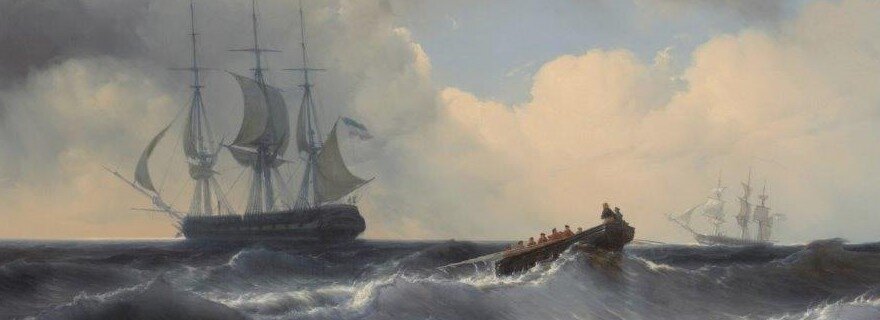 |
| Louis Meijer, Man overboord, 1847, olie on canvas, 129 x 198 cm. Credit: National Maritime Museum collection, Amsterdam |
Long into the 19th century, seascapes were considered an expression of patriotism. Artists who painted in a 17th-century style were valued more. This tradition stifled innovation in the genre, Cécile Bosman has concluded. She will defend her Ph.D. thesis on 13 October.
Think seascapes and you'll most likely conjure up images of historical sailing ships bravely battling roiling waves against a backdrop of thunderous black clouds. And that isn't surprising seeing as for a long time many seascapes were painted according to specific traditions. The genre flourished in the 17th century and made a comeback in the 19th century. As curator of maritime art at the National Maritime Museum in Amsterdam, external Ph.D. candidate Cécile Bosman realized that the genre deserved further research. I wondered how maritime art was viewed in the 19th century, but no studies had been published of how exactly the paintings belonged to their time. Bosman researched the perspective of maritime painters and other painters in the profession. She also studied how art critics and art theorists viewed the genre.
In the art world of the late 18th and entire 19th century, the prevailing opinion was that maritime art was representative of national pride. That idea was based on, among others, the cultural and economic heyday of the 17th century Dutch Republic, which had its roots in the shipping of the time. In the 18th and 19th centuries, this prosperous history was glorified and used as an example.
Maritime art as an expression of patriotism was typically Dutch. Because within 19th-century European nationalism, it was principally history painting paintings of historical scenes that was used to create awareness of a nation's own history.
Bosman identified 110 specialized maritime artists who were active between 1800 and 1900. Many gained their inspiration from 17th-century Dutch masters of the seascape such as Ludolf Bakhuizen and Willem van de Velde. Art critics used traditional style criteria to judge their work at least into the mid-19th century, Bosman concludes. They mainly looked at the resemblance to 17th-century art in the treatment of the elements: the transparency of the water's surface, the colors of the sky and clouds, and the shape of the waves.
Bosman said, in many ways, the 17th century was never far away. What was typical of this time was how for a long time art criticism ignored contemporary modern steamships in the paintings.
This artistic tradition was responsible for expert paintings, but it was stifling too. It resulted in a form of inability to deal with innovations in painting. From the mid-19th century onwards, that increasingly began to rankle. The artistic tradition of 17th-century Dutch painting was considered passé by many artists and art critics, and it began to make way for realism and impressionism. Here there was no room for precisely painted ships, and people lost interest in specialized maritime art. The maritime painters missed the boat at the end of the century, literally and figuratively.



0 Comments